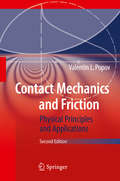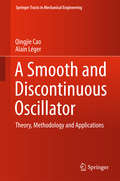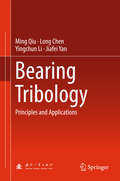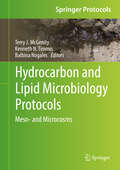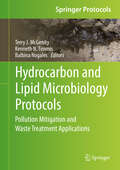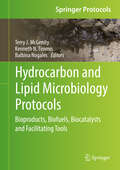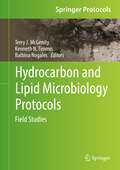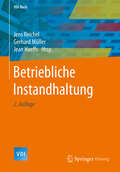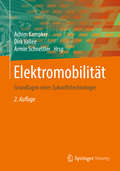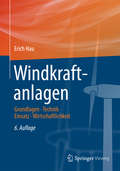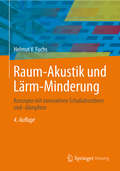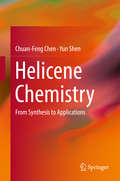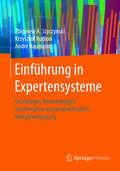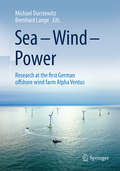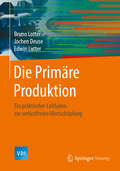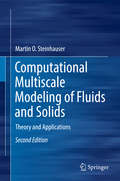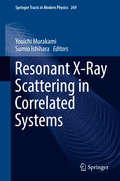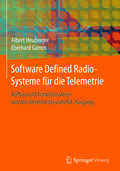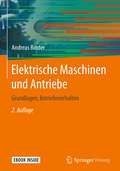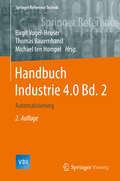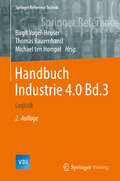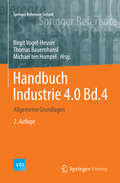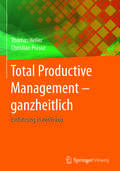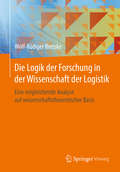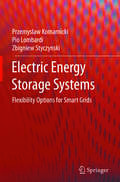- Table View
- List View
Contact Mechanics and Friction: Physical Principles and Applications
by Valentin L. PopovThis application-oriented book introduces readers to the associations and relationships between contact mechanics and friction, providing them with a deeper understanding of tribology. It addresses the related phenomena of contacts, adhesion, capillary forces, friction, lubrication, and wear from a consistent point of view. The author presents (1) methods for rough estimates of tribological quantities, (2) simple and general methods for analytical calculations, and (3) the crossover into numerical simulation methods, the goal being to convey a consistent view of tribological processes at various scales of magnitude (from nanotribology to earthquake research).The book also explores the system dynamic aspects of tribological systems, such as squeal and its suppression, as well as other types of instabilities and spatial patterns. It includes problems and worked-out solutions for the respective chapters, giving readers ample opportunity to apply the theory to practical situations and to deepen their understanding of the material discussed.The second edition has been extended with a more detailed exposition of elastohydrodynamic lubrication, an updated chapter on numerical simulation methods in contact mechanics, a new section on fretting in the chapter on wear, as well as numerous new exercises and examples, which help to make the book an excellent reference guide.
A Smooth and Discontinuous Oscillator: Theory, Methodology and Applications (Springer Tracts in Mechanical Engineering)
by Qingjie Cao Alain LégerThis is the first book to introduce the irrational elliptic function series, providing a theoretical treatment for the smooth and discontinuous system and opening a new branch of applied mathematics. The discovery of the smooth and discontinuous (SD) oscillator and the SD attractors discussed in this book represents a further milestone in nonlinear dynamics, following on the discovery of the Ueda attractor in 1961 and Lorenz attractor in 1963.This particular system bears significant similarities to the Duffing oscillator, exhibiting the standard dynamics governed by the hyperbolic structure associated with the stationary state of the double well. However, there is a substantial departure in nonlinear dynamics from standard dynamics at the discontinuous stage. The constructed irrational elliptic function series, which offers a way to directly approach the nature dynamics analytically for both smooth and discontinuous behaviours including the unperturbed periodic motions and the perturbed chaotic attractors without any truncation, is of particular interest. Readers will also gain a deeper understanding of the actual nonlinear phenomena by means of a simple mechanical model: the theory, methodology, and the applications in various interlinked disciplines of sciences and engineering. This book offers a valuable resource for researchers, professionals and postgraduate students in mechanical engineering, non-linear dynamics, and related areas, such as nonlinear modelling in various fields of mathematics, physics and the engineering sciences.
Bearing Tribology: Principles and Applications
by Ming Qiu Long Chen Yingchun Li Jiafei YanBy focusing on the theory and techniques of tribological design and testing for bearings, this book systematically reviews the latest advances in applications for this field. It describes advanced tribological design, theory and methods, and provides practical technical references for investments in bearing design and manufacturing. The theories, methods and cases in this book are largely derived from the practical engineering experience gained and research conducted by the author and her team since the 2000s. The book includes academic papers, technical reports and patent literature, and offers a valuable guide for engineers involved in bearing design.
Hydrocarbon and Lipid Microbiology Protocols: Meso- and Microcosms (Springer Protocols Handbooks)
by Terry J. McGenity, Kenneth N. Timmis and Balbina NogalesThis Volume describes methods for simulating natural environments by using reproducible and controllable meso- and microcosm experiments to analyse hydrocarbon-degrading microorganisms and to test hypotheses. It presents important aspects of the preparation of experimental set-ups, hydrocarbon application and sampling, and features protocols for experiments with different types of samples, such as biofilms, aquatic systems (e.g. groundwater, streams), and sediments, including oscillating oxic-anoxic mesocosms, as well as for in-situ experimentation in subtidal and deep sediments. Two chapters are dedicated to cultivation under high-pressure conditions, and several chapters include protocols for processing samples for downstream chemical, microbial or activity analyses. Several of the approaches presented are generic and will benefit anyone embarking on designing meso- and microcosm experiments. Hydrocarbon and Lipid Microbiology Protocols There are tens of thousands of structurally different hydrocarbons, hydrocarbon derivatives and lipids, and a wide array of these molecules are required for cells to function. The global hydrocarbon cycle, which is largely driven by microorganisms, has a major impact on our environment and climate. Microbes are responsible for cleaning up the environmental pollution caused by the exploitation of hydrocarbon reservoirs and will also be pivotal in reducing our reliance on fossil fuels by providing biofuels, plastics and industrial chemicals. Gaining an understanding of the relevant functions of the wide range of microbes that produce, consume and modify hydrocarbons and related compounds will be key to responding to these challenges. This comprehensive collection of current and emerging protocols will facilitate acquisition of this understanding and exploitation of useful activities of such microbes.
Hydrocarbon and Lipid Microbiology Protocols: Pollution Mitigation and Waste Treatment Applications (Springer Protocols Handbooks)
by Terry J. McGenity, Kenneth N. Timmis and Balbina NogalesThis Volume presents applications of hydrocarbon microbiology in the context of environmental pollutant degradation, covering pollutants such as petroleum and related wastes (i.e. oil sludge), biofuels, lipid-rich wastes, chlorinated solvents and BTEX, in several environments (marine, soil, groundwater). The approaches presented range from laboratory experiments and treatment in reactors to field applications. Two chapters highlight innovative approaches to address relevant questions in pollutant degradation, such as low environmental concentrations of pollutants, and the biodegradation of complex pollutant mixtures using biofilms. Rather than presenting the applications in the form of protocols, some of the chapters in this Volume include detailed practical information on the opportunities offered by and limitations of the different approaches, providing valuable information for researchers planning to perform bioremediation experiments. Hydrocarbon and Lipid Microbiology Protocols There are tens of thousands of structurally different hydrocarbons, hydrocarbon derivatives and lipids, and a wide array of these molecules are required for cells to function. The global hydrocarbon cycle, which is largely driven by microorganisms, has a major impact on our environment and climate. Microbes are responsible for cleaning up the environmental pollution caused by the exploitation of hydrocarbon reservoirs and will also be pivotal in reducing our reliance on fossil fuels by providing biofuels, plastics and industrial chemicals. Gaining an understanding of the relevant functions of the wide range of microbes that produce, consume and modify hydrocarbons and related compounds will be key to responding to these challenges. This comprehensive collection of current and emerging protocols will facilitate acquisition of this understanding and exploitation of useful activities of such microbes.
Hydrocarbon and Lipid Microbiology Protocols: Bioproducts, Biofuels, Biocatalysts and Facilitating Tools (Springer Protocols Handbooks)
by Terry J. McGenity, Kenneth N. Timmis and Balbina NogalesThis Volume covers protocols for various applications in hydrocarbon microbiology, including those of interest for industrial processes, biocatalysis, lipid and biofuel production, bioproducts, or the human microbiome. It presents detailed protocols for the functional screening of enzymes acting on greasy molecules (i.e. lipases, esterases), including assays for enantioselective biocatalysts, as well as approaches for protein display technologies. Protocols for improving fuel quality and production of biofuel and lipids in different hosts (bacteria, algae, yeast) are also provided. The production of biogas from organic waste and its fermentation into value-added products such as polyhydroxyalkanoates is covered, as well as an in-vitro model of the gut microbiome for short-chain fatty acid metabolism and microbial diversity analyses. The applications presented are examples of the many potential applications in hydrocarbon and lipid microbiology, and many (i.e. protein-display technologies) will also be of interest in other research fields. Hydrocarbon and Lipid Microbiology Protocols There are tens of thousands of structurally different hydrocarbons, hydrocarbon derivatives and lipids, and a wide array of these molecules are required for cells to function. The global hydrocarbon cycle, which is largely driven by microorganisms, has a major impact on our environment and climate. Microbes are responsible for cleaning up the environmental pollution caused by the exploitation of hydrocarbon reservoirs and will also be pivotal in reducing our reliance on fossil fuels by providing biofuels, plastics and industrial chemicals. Gaining an understanding of the relevant functions of the wide range of microbes that produce, consume and modify hydrocarbons and related compounds will be key to responding to these challenges. This comprehensive collection of current and emerging protocols will facilitate acquisition of this understanding and exploitation of useful activities of such microbes.
Hydrocarbon and Lipid Microbiology Protocols: Field Studies (Springer Protocols Handbooks)
by Terry J. McGenity, Kenneth N. Timmis and Balbina NogalesThis Volume describes methods for investigating microbes in their natural environment and how to obtain representative samples and preserve them for subsequent analyses. Chapters are arranged according to the environments under investigation, which include: oil reservoirs, fracking fluids, aquifers, coal beds, oil sands and their tailing ponds, lakes, rivers, leaves, polar seas and ice, the sea-surface microlayer, mud flats, microbialites, and deep-sea fauna. A variety of downstream analytical procedures are described, including: nucleic-acid extraction and preparation for high-throughput sequencing, fluorescence in-situ hybridisation, and cultivation of aerobic and anaerobic hydrocarbon-degrading microbes. Though most chapters focus on hydrocarbon-rich environments, many of the approaches used are generic, and as such will be of value to researchers embarking on studies of microbes and their processes in the field. Hydrocarbon and Lipid Microbiology Protocols There are tens of thousands of structurally different hydrocarbons, hydrocarbon derivatives and lipids, and a wide array of these molecules are required for cells to function. The global hydrocarbon cycle, which is largely driven by microorganisms, has a major impact on our environment and climate. Microbes are responsible for cleaning up the environmental pollution caused by the exploitation of hydrocarbon reservoirs and will also be pivotal in reducing our reliance on fossil fuels by providing biofuels, plastics and industrial chemicals. Gaining an understanding of the relevant functions of the wide range of microbes that produce, consume and modify hydrocarbons and related compounds will be key to responding to these challenges. This comprehensive collection of current and emerging protocols will facilitate acquisition of this understanding and exploitation of useful activities of such microbes.
Betriebliche Instandhaltung (VDI-Buch)
by Jens Reichel Gerhard Müller Jean HaeffsIn seiner über 30-jährigen Geschichte hat sich der VDI-Hauptausschuss darum bemüht, dass das Thema Instandhaltung öffentlich diskutiert und wissenschaftlich untersucht wird. Erkenntnisse zu effizienten Vorgehensweisen, Methoden und Strategien sind zum Teil in Richtlinien dokumentiert. Das Buch reflektiert die Entwicklung der Instandhaltung in den letzten Jahren. Es sammelt die Beiträge zur Festveranstaltung im Juni 2009.
Elektromobilität: Grundlagen einer Zukunftstechnologie
by Achim Kampker Dirk Vallée Armin SchnettlerDie Automobilindustrie befindet sich in einem tiefgreifenden Wandel. Mit der Elektromobilität verändern sich bisherige Fahrzeug- und Antriebskonzepte grundlegend – und damit auch der gesamte Wertschöpfungsprozess. Das Buch liefert einen umfassenden Überblick über die Herausforderungen und die Lösungen zu allen Aspekten der Elektromobilität: von der Produktentwicklung über die Produktion von Elektrofahrzeugen mit Hinweisen für die Konstruktion des Antriebsstrangs bis hin zum Aufbau einer Infrastruktur und zu Geschäftsmodellen. Für die zweite Auflage wurden sämtliche Inhalte auf den aktuellen Stand der technologischen Entwicklung gebracht. Das Thema Batterieproduktion wurde ebenso erweitert wie die damit verknüpfte Frage des Remanufacturings als Teil des Recycling-Kreislaufes. Das Buch gliedert sich in fünf Kapitel. Im Grundlagenkapitel werden die Herausforderungen der Elektromobilität beschrieben und die Ansätze für eine integrierte Produkt-, Prozess- und Infrastrukturentwicklung skizziert. Darüber hinaus bietet es umfassende Einblicke in die Montage von Elektrofahrzeugen. In den folgenden Kapiteln werden Konzepte für den Städtebau und für den Aufbau eines Servicenetzes vorgestellt sowie Geschäftsmodelle, ihre Entwicklung und Rechtsgrundlagen erläutert. Im Kapitel Fahrzeugkonzeption geht es um den Prozess der Industrialisierung und Fragen der Batterieproduktion. Die Entwicklung von elektrofahrzeugspezifischen Komponenten wie der des Antriebsstrangs wird im abschließenden Kapitel „Entwicklung von elektrofahrzeugspezifischen Systemen“ beschrieben.
Windkraftanlagen: Grundlagen. Technik. Einsatz. Wirtschaftlichkeit
by Erich HauDas Handbuch behandelt die Technologie von Windkraftanlagen systematisch und umfassend. Nach einem Abriss der historischen Entwicklung werden die physikalisch-technischen Grundlagen der Windenergiewandlung sowie Konstruktion, Einsatzkonzeptionen und Betriebseigenschaften von Windkraftanlagen, ihre Umweltverträglichkeit und Wirtschaftlichkeit analysiert und an Beispielen dargestellt. Die 5. Auflage wurde um neueste technische Entwicklungen ergänzt, die Offshore-Nutzung wird ausführlich besprochen. Der Band enthält viele detaillierte Abbildungen.
Raum-Akustik und Lärm-Minderung: Konzepte mit innovativen Schallabsorbern und -dämpfern (VDI-Buch)
by Helmut V. FuchsDie 4. Auflage dieses inzwischen als Standardwerk anerkannten Fachbuchs greift wieder aktuelle Probleme bei der Gestaltung von Raum-Akustik, Freifeld-Prüfständen und Kanal-Auskleidungen auf. Zu deren nachhaltiger Lösung werden Materialien und Bauteile sowie Auslegungskonzepte nach neuestem Stand des Wissens allgemein verständlich dargestellt. Aufbauend auf den Grundlagen wird das Konzept vertieft. Mehr als 100 Fallbeispiele zeigen, welche konstruktiven und baulichen Maßnahmen schnell und kostengünstig zum Ziel führen können. Akustiker in der Praxis und Forschung sowie entwerfende und planende Architekten, Bauingenieure und Haustechniker finden neben den Grundlagen und Konzepten besonders auf für bisher vernachlässigten Bereich der tiefen Frequenzen wichtige Hinweise. In Darstellung und Lösung akuter schalltechnischer Probleme stellt der Autor auch neue Erkenntnisse und Konzepte zur Verfügung, bei denen stets das praktisch Nützliche im Vordergrund steht. Für die eingeführten Normen werden Problemlösungen ebenso behandelt wie die Grenzen der Anwendung, wo weiterführende Lösungen gesucht werden. Für Lärmprobleme in Arbeits- und Freizeit-Räumen liefert das Buch eine Fülle konstruktiver Anregungen.
Helicene Chemistry: From Synthesis to Applications
by Chuan-Feng Chen Yun ShenThis book systematically reviews recent advances in the synthetic methods and applications of helicenes. The first part of this book introduces the nomenclature and structural features of helicenes. The second part reviews several classic and useful methods as well as recently-developed approaches for the preparation and functionalization of helicenes, including photocyclization and Diels-Alder reactions, which are two important breakthroughs in the syntheses of helicenes. In the last part, the applications of helicenes in asymmetric syntheses, molecular machines, molecular recognition, self-assembly and other fields are discussed. This book provides a useful reference source for researchers and graduate students working not only in the area of helicene chemistry, but also in other research areas including materials science, supramolecular chemistry, coordination chemistry, and physical organic chemistry. Chuan-Feng Chen is a Professor at the Institute of Chemistry, Chinese Academy of Sciences, China.
Einführung in Expertensysteme: Grundlagen, Anwendungen und Beispiele aus der elektrischen Energieversorgung
by Zbigniew A. Styczynski Krzysztof Rudion André NaumannDieses Buch behandelt den Aufbau und den Einsatz von Expertensystemen in technischen Systemen an Beispielen der elektrischen Energieversorgung.Nach einem geschichtlichen Abriss zur Entstehung und Verwendung von Expertensystemen werden die Grundlagen der Prädikatenlogik als Fundament wissensbasierter Systeme erklärt. Die Grundzüge der wissensbasierten Systeme, der Wissensakquisition und der Wissensspeicherung werden erläutert und ausgewählte intelligente Techniken vorgestellt. Mit zahlreichen Illustrationsbeispielen aus dem Gebiet der elektrischen Energieversorgung werden die spezifischen Probleme der Gestaltung von Expertensystemen in diesem Umfeld erläutert.Die ZielgruppenDas Werk ist in erster Linie für Studierende und Ingenieure der technischen Fächer, insbesondere der Elektrotechnik gedacht, die einen Einstieg in die Problematik suchen.
Sea – Wind – Power: Research at the first German offshore wind farm Alpha Ventus
by Michael Durstewitz Bernhard Lange Alistair A. TarwidThis book reports on the objectives, methods used and difficulties faced by the RAVE research projects, and presents the results and their significance for the future use of offshore wind energy in a style that is understandable for everyone.Readers are given a comprehensive overview of the current status of offshore wind energy research and the results of the research activities. Offshore wind energy will play a significant role in our future energy supply, yet this development has really only just begun. A large team of experts from the fields of research, industry, public administration and government therefore set themselves the goal of investigating the current and fundamental issues relating to the use of offshore wind energy. They worked on interdisciplinary research projects with the aim of expanding our knowledge and finding application-oriented solutions. Their work has contributed to establishing offshore wind energy as a reliable, sustainable and economical long term source of energy.
Die Primäre Produktion: Ein praktischer Leitfaden zur verlustfreien Wertschöpfung (VDI-Buch)
by Bruno Lotter Jochen Deuse Edwin LotterDas Buch stellt einen ausgereiften Leitfaden vor, wie Produkte und Arbeitssysteme so zu gestalten sind, dass sowohl wirtschaftliche wie ergonomische Forderungen aufgrund des demografischen Wandels erfüllt werden. Dies geschieht aufbauend auf der bewährten Primär-Sekundär-Analyse als methodischem Fundament. Konkrete Beispiele verdeutlichen die Vorgehensweise im Detail. Die stetige Produktivitätssteigerung produzierender Unternehmen ist im globalen Wettbewerb unverzichtbar. Als Leitgedanke hierzu dient eine Produktion, die Verluste durch nicht wertschöpfende sekundäre Aufwendungen vermeidet und möglichst nur primäre, also wertschöpfende Aufwendungen, leistet. Insgesamt wurden die Erkenntnisse aus mehreren Verbund-Forschungsvorhaben und vielen realisierten Industrieprojekten praxisgerecht aufgearbeitet und zur unmittelbaren Nutzung für die Produktionsindustrie bereit gestellt. Ihre schrittweise und geduldige Umsetzung bietet einen erfolgversprechenden Weg zu einer verschwendungsfreien Wertschöpfung.
Computational Multiscale Modeling of Fluids and Solids: Theory and Applications
by Martin Oliver SteinhauserThe idea of the book is to provide a comprehensive overview of computational physics methods and techniques, that are used for materials modeling on different length and time scales. Each chapter first provides an overview of the basic physical principles which are the basis for the numerical and mathematical modeling on the respective length-scale. The book includes the micro-scale, the meso-scale and the macro-scale, and the chapters follow this classification. The book explains in detail many tricks of the trade of some of the most important methods and techniques that are used to simulate materials on the perspective levels of spatial and temporal resolution. Case studies are included to further illustrate some methods or theoretical considerations. Example applications for all techniques are provided, some of which are from the author’s own contributions to some of the research areas. The second edition has been expanded by new sections in computational models on meso/macroscopic scales for ocean and atmosphere dynamics. Numerous applications in environmental physics and geophysics had been added.
Resonant X-Ray Scattering in Correlated Systems (Springer Tracts in Modern Physics #269)
by Youichi Murakami Sumio IshiharaThe research and its outcomes presented here is devoted to the use of x-ray scattering to study correlated electron systems and magnetism. Different x-ray based methods are provided to analyze three dimensional electron systems and the structure of transition-metal oxides. Finally the observation of multipole orderings with x-ray diffraction is shown.
Software Defined Radio-Systeme für die Telemetrie: Aufbau und Funktionsweise von der Antenne bis zum Bit-Ausgang
by Eberhard Gamm Albert HeubergerDieses Buch behandelt alle für ein Software Defined Radio (SDR) relevanten Systemteile: Antenne, Antennenanpassung, analoges Frontend, A/D-Umsetzung, Digital Downconversion (DDC), Interpolation, Synchronisation, Demodulation. Zunächst werden die notwendigen Grundlagen für die Darstellung von Signalen vermittelt sowie der gesamte Aufbau eines Software Defined Radios beschrieben, um anschließend die einzelnen Komponenten näher zu betrachten.Der Schwerpunkt des Buches liegt auf dem Zusammenspiel der Komponenten und Signale innerhalb des Empfängers. Zur Veranschaulichung der Signale wird das Open-Source-Programm GNU Octave verwendet.
Elektrische Maschinen und Antriebe: Grundlagen, Betriebsverhalten
by Andreas BinderDas Buch führt in einem weiten Bogen von den physikalischen Grundlagen zum Verständnis des stationären und des dynamischen Betriebsverhaltens elektrischer Maschinen und Antriebe. Besonderes Augenmerk wird auf die aktuellen Motorentwicklungen gelegt. Dazu werden die Grundlagen elektrischer Maschinen anhand der drei Grundtypen Asynchronmaschine, Synchronmaschine und Gleichstrommaschine ausführlich besprochen, Bauweisen werden erläutert, und das stationäre Betriebsverhalten wird hergeleitet.Neben der anschaulichen Beschreibung anhand modern ausgeführter Maschinen wird die mathematisch fundierte Grundlage von Anfang an mitentwickelt. Bewusst wird die Drehstromtechnik in den Vordergrund gestellt, da sie die klassische Gleichstromtechnik immer weiter in Nischen verdrängt. Aktuelle Motorentwicklungen vor allem im Zusammenhang mit Umrichterspeisung werden ausführlich besprochen. Auch auf Sonderprobleme wie zusätzliche Verluste und Geräusche bei Umrichterspeisung wird ausführlich eingegangen.An die stationäre Theorie schließt sich im zweiten Teil die dynamische Theorie für alle drei Grundtypen von E-Maschinen an, so dass Anlaufvorgänge, plötzliche Kurzschlüsse oder Lastwechsel verstanden werden.Jedes Kapitel enthält durchgerechnete Praxisbeispiele, die oft mit Messergebnissen unterlegt sind. Die Beispiele reichen von Netz- und Umrichter gespeisten Motoren bis hin zu Großgeneratoren im Kraftwerksbereich.In der zweiten Auflage wurden einige Textpassagen überarbeitet und an manchen Stellen nötige Korrekturen durchgeführt, aber der Inhalt im Wesentlichen beibehalten.Eine Aufgabensammlung mit durchgerechneten Anwendungsbeispielen desselben Autors erscheint in einer erweiterten zweiten Auflage als gesonderter Band.Die Zielgruppen Ingenieurinnen, Ingenieure und Studierende der Fachrichtungen „Elektrotechnik“, „Mechatronik“, „Antriebstechnik“, „Energietechnik“ und „Maschinenbau“
Handbuch Industrie 4.0 Bd.2: Automatisierung (Springer Reference Technik)
by Birgit Vogel-Heuser Thomas Bauernhansl Michael Ten HompelMit der Neuauflage des erfolgreichen Werkes wird die Geschichte der vierten industriellen Revolution fortgeschrieben und der Dynamik Rechnung getragen, mit der diese Vision in den vergangenen zwei bis drei Jahren weiterentwickelt und verwirklicht wurde. Experten aus Wissenschaft und Technik beleuchten verschiedene Facetten der Industrie 4.0 sowohl aus akademischer als auch aus praktischer Sicht und schaffen gleichermaßen einen Überblick über den Stand der Technik und die Vision selbst. Dies gelingt nicht zuletzt mit einer guten Mischung aus wissenschaftlichen Erkenntnissen, Praxisbeispielen und Übersichtsbeiträgen. Thematisch reicht das Spektrum von Basistechnologien (z. B. cyber-physische Systeme) über Integrations- und Migrationsansätze bis hin zu Geschäftsmodellen und Dienstleistungen. Zudem werden neben der Datensicherheit auch rechtliche Aspekte thematisiert.Die zweite Auflage wurde bearbeitet und erweitert, erscheint nun in 4 Bänden. Dieser zweite Band beinhaltet neue und bearbeitete Beiträge zur Automatisierung. Online ist dieses Nachschlagewerk auch über Springer Reference verfügbar.
Handbuch Industrie 4.0 Bd.3: Logistik (Springer Reference Technik)
by Birgit Vogel-Heuser Thomas Bauernhansl Michael Ten HompelMit der Neuauflage des erfolgreichen Werkes wird die Geschichte der vierten industriellen Revolution fortgeschrieben und der Dynamik Rechnung getragen, mit der diese Vision in den vergangenen zwei bis drei Jahren weiterentwickelt und verwirklicht wurde. Experten aus Wissenschaft und Technik beleuchten verschiedene Facetten der Industrie 4.0 sowohl aus akademischer als auch aus praktischer Sicht und schaffen gleichermaßen einen Überblick über den Stand der Technik und die Vision selbst. Dies gelingt nicht zuletzt mit einer guten Mischung aus wissenschaftlichen Erkenntnissen, Praxisbeispielen und Übersichtsbeiträgen. Thematisch reicht das Spektrum von Basistechnologien (z. B. cyber-physische Systeme) über Integrations- und Migrationsansätze bis hin zu Geschäftsmodellen und Dienstleistungen. Zudem werden neben der Datensicherheit auch rechtliche Aspekte thematisiert.Die zweite Auflage wurde bearbeitet und erweitert, erscheint nun in 4 Bänden. Dieser dritte Band umfasst die neuen und erneuerten Beiträge zur Industrie 4.0 in der Logistik. Online ist dieses Nachschlagewerk auch über Springer Reference verfügbar.
Handbuch Industrie 4.0 Bd.4: Allgemeine Grundlagen (Springer Reference Technik)
by Birgit Vogel-Heuser Thomas Bauernhansl Michael Ten HompelMit der Neuauflage des erfolgreichen Werkes wird die Geschichte der vierten industriellen Revolution fortgeschrieben und der Dynamik Rechnung getragen, mit der diese Vision in den vergangenen zwei bis drei Jahren weiterentwickelt und verwirklicht wurde. Experten aus Wissenschaft und Technik beleuchten verschiedene Facetten der Industrie 4.0 sowohl aus akademischer als auch aus praktischer Sicht und schaffen gleichermaßen einen Überblick über den Stand der Technik und die Vision selbst. Dies gelingt nicht zuletzt mit einer guten Mischung aus wissenschaftlichen Erkenntnissen, Praxisbeispielen und Übersichtsbeiträgen. Thematisch reicht das Spektrum von Basistechnologien (z. B. cyber-physische Systeme) über Integrations- und Migrationsansätze bis hin zu Geschäftsmodellen und Dienstleistungen. Zudem werden neben der Datensicherheit auch rechtliche Aspekte thematisiert.Die zweite Auflage wurde bearbeitet und erweitert, erscheint nun in 4 Bänden. Dieser vierte Band umfasst die Beiträge zur Industrie 4.0 mit unveränderter, nachhaltiger Bedeutung in der Produktion, Automatisierung und Logistik. Online ist dieses Nachschlagewerk auch über Springer Reference verfügbar.
Total Productive Management - ganzheitlich: Einführung in der Praxis
by Thomas Heller Christian PrasseDas Buch ist ein praktischer Leitfaden für die Einführung des Total Productive Management (TPM) im Unternehmen. Es baut auf den konkreten Arbeitsalltag auf. Weitgehende Digitalisierung und Industrie 4.0 werden durch die kontinuierliche Modernisierung und Erhöhung der Wertschöpfung umgesetzt. Nicht die Technologien alleine, auch die (Re-)Organisation der Arbeit ändert sich. "Smartes" Total Productive Management, welches genau diese Anforderungen aufgreift, liefert die erforderlichen Werkzeuge für die notwendige Transformation.TPM steht für eine kontinuierliche Verbesserung aller Bereiche und Abläufe. Mittelpunkt sind dabei die Mitarbeiter, die mit ihrem Einsatz und ihren Fähigkeiten die Produktivität sicherstellen. Grundvoraussetzung zur erfolgreichen Einführung eines TPM-Systems ist die Einbindung aller Beteiligten, vom Geschäftsführer bis zum Mitarbeiter in der Produktion. An Beispielen wird erläutert, wie Transparenz, Akzeptanz und Motivation - die bei der Umsetzung entscheidende Faktoren – erfolgreich erzeugt werden können. Zahlreiche Checklisten ermöglichen eine Einschätzung der Situation im Unternehmen und helfen bei der Umsetzung.Ein TPM System muss kompatibel zum Unternehmen sein. Es muss sich integrieren lassen in die vorhandenen Systematiken, z. B. Betriebliches Vorschlagswesen, QS-System. Gute Methoden und Systeme können erhalten bleiben.Auch wenn es bei Ihnen noch kein Management-System gibt liefert dieses Buch das notwendige Rüstzeug für die Kontinuierliche Verbesserung der Abläufe in Produktion und Instandhaltung,Höhere Verfügbarkeit und Zuverlässigkeit der Maschinen und Anlagen,Sauberkeit und Sicherheit,Weniger und kürzere Stillstände,Transparenz von Abläufen.Eine positive Außendarstellung gegenüber Kunden wird mit TPM erheblich erleichtert.
Die Logik der Forschung in der Wissenschaft der Logistik: Eine vergleichende Analyse auf wissenschaftstheoretischer Basis
by Wolf-Rüdiger BretzkeZiel dieses Buches ist es, ein Nachdenken (idealerweise eine Diskussion) über ein grundlegendes, methodologisches Problem in der Wissenschaft von der Logistik anzuregen (gelegentlich auch zu provozieren) - ein Problem, über das niemand spricht, obwohl es für die Fortentwicklung dieser Disziplin von grundlegender Bedeutung ist. Dieser Disziplin mangelt es an einer kritischen Reflexion der Erfolgsvoraussetzungen und Grenzen des eigenen Forschens, und das gilt im Grundsatz für alle drei hier beleuchteten Forschungsansätze. Dementsprechend kann eine solche Reflexion auch große Chancen erschließen, für die Wissenschaft und für die Praxis.
Electric Energy Storage Systems: Flexibility Options for Smart Grids
by Przemyslaw Komarnicki Pio Lombardi Zbigniew StyczynskiThe book describes methods of modeling, planning and implementing electric energy storage systems. Energy storage becomes an important issue when more and more electric power is generated by wind mills and photovoltaics systems, because green energy is more volatile. So energy storage is necessary to guarantee safe and secure electric energy supply.Market and power system oriented operations of electric energy storage require different planning methods and different algorithms for searching the optimal solution. These methods are described in detail for energy storage implementations in generation, transmission and distribution levels. Economic aspects are considered.For many years, the authors have been developing smart grid solutions as well as a methology of modeling and planning electric energy storage usage. The aim has been to increase the flexibility of the power system heading for an energy system which is completely generated by green energy.
